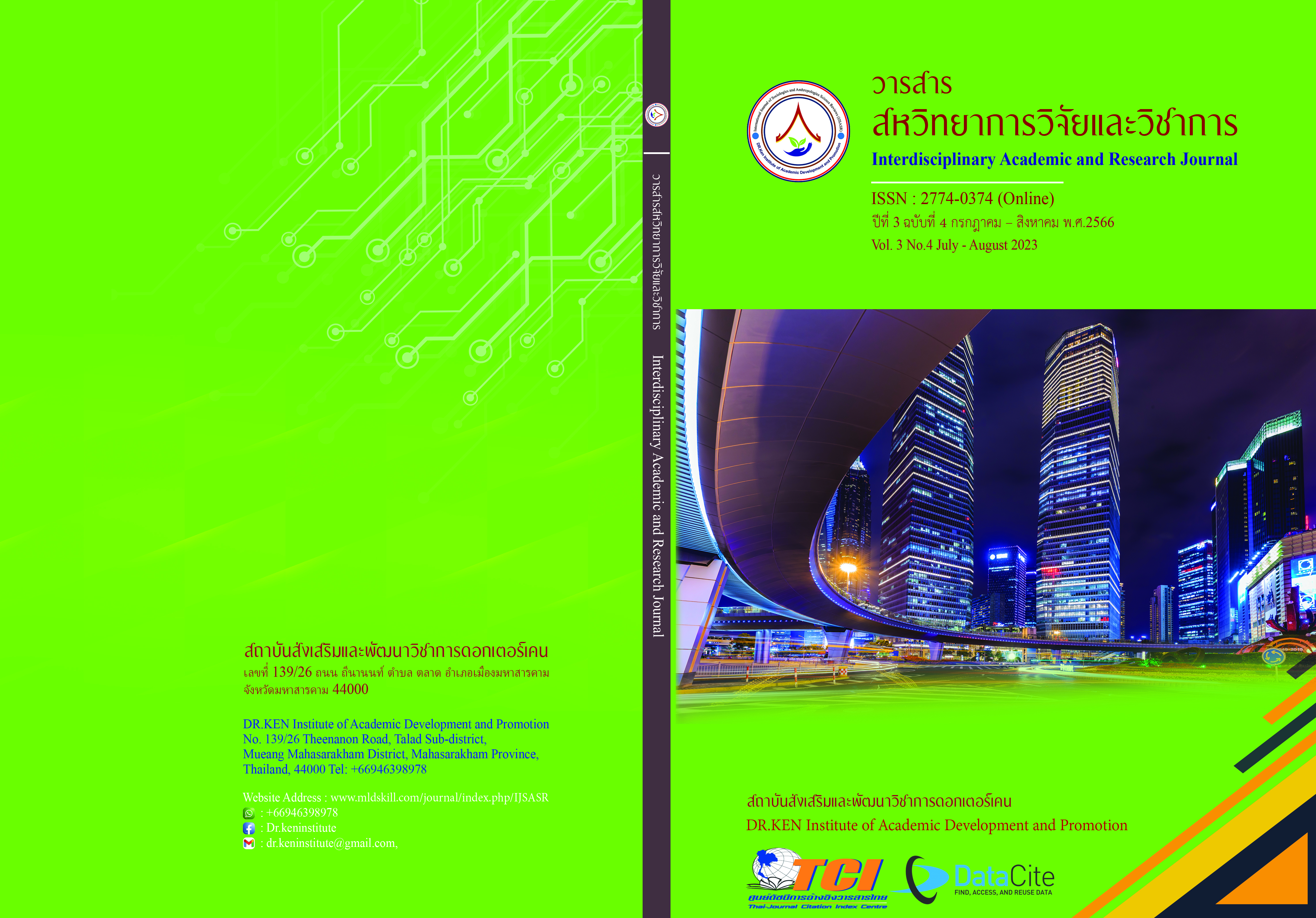Strategies for Driving and Creative about Art of Anuban Prachuap Khiri Khan School Under Prachuap Khiri Khan Primary Educational Service Area Office 1
DOI:
https://doi.org/10.14456/iarj.2023.195Keywords:
Strategies for Driving and Developing; , Art Creativity Thinking; , Creativity Based LearningAbstract
The objectives of this research were to study 1) strategies for driving art creative thinking development, 2) strategies for developing art creative thinking of students, and 3) the results of art creative thinking development of students at Anuban Prachuap Khiri Khan School under Prachuap Khiri Khan Primary Educational Service Area Office 1. The action research was used in this study. The samples consisted of 3 art subject network teachers, 40 Prathomsueksa 6 students. The research tools were 1) the manual for developing students' art creative thinking, and 2) student’s creativity assessment form. Both instruments had the item-objective congruence Index between 0.67-1.00. The data were analyzed by using mean, standard deviation, and percentage of progress. The research revealed that: (1) Strategies for driving art creative thinking development of students were 1) network strategy, 2) communication strategy, 3) participatory strategy, and 4) integration strategy. (2) Strategies for developing art creative thinking of students were creative-based learning management including 5 steps: 1) arouse interest, 2) set problems and divide students into groups according to their interests, 3) research and think, 4) present, and 5) evaluate. (3) The art creative thinking of students after studying was higher than before with a progression percentage of 28.44 %.
References
กนิษฐา พูลลาภ. (2563). การส่งเสริมความคิดสร้างสรรค์ด้วยการจัดการเรียนรู้แบบผสมผสาน ร่วมกับการเรียนรู้แบบสร้างสรรค์เป็นฐาน สำหรับนักเรียนห้องเรียนพิเศษวิทยาศาสตร์ ชั้นมัธยมศึกษาปีที่ 4 โรงเรียนผดุงนารี. วิทยานิพนธ์ครุศาสตรมหาบัณฑิต สาขาวิชาคอมพิวเตอร์ศึกษา คณะครุศาสตร์ มหาวิทยาลัยราชภัฏมหาสารคาม.
กฤษณา ทิมสี. (2562). การพัฒนาความคิดสร้างสรรค์และผลสัมฤทธิ์ทางการเรียนโดยใช้วิธีสอนแบบสร้างสรรค์เป็นฐาน (CBL) ของนักเรียนชั้นมัธยมศึกษาปีที่ 1. กำแพงเพชร: โรงเรียนเรืองวิทย์พิทยาคม สำนักงานเขตพื้นที่การศึกษามัธยมศึกษาเขต 41.
คณะกรรมการอิสระเพื่อการปฏิรูปการศึกษา. (2562). แผนการปฏิรูปประเทศด้านการศึกษา/คณะกรรมการอิสระเพื่อการปฏิรูปการศึกษา. กรุงเทพฯ : สำนักงานเลขาธิการสภาการศึกษา.
บุญยนุช สิทธาจารย์. (2560). การพัฒนาชุดการสอนศิลปะตามแนวคิดสะตีมศึกษาเพื่อส่งเสริมกระบวนการสร้างสรรค์สำรับนักเรียนชั้นประถมศึกษาปีที่ 5. วิทยานิพนธ์ครุศาสตร์มหาบัณฑิต สาขาวิชาศิลปศึกษา ภาควิชาศิลปะ ดนตรี และนาฏศิลป์ศึกษา จุฬาลงกรณ์มหาวิทยาลัย.
ยุรนันท์ วรรณรักษ์. (2562). กลยุทธ์การขับเคลื่อนและการพัฒนาทักษะการฟังและพูดภาษาอังกฤษของนักเรียนในสถานศึกษา สังกัดสำนักงานเขตพื้นที่การศึกษาประถมศึกษาประจวบคีรีขันธ์ เขต 2. วิทยานิพนธ์ครุศาสตรมหาบัณฑิต สาขาวิชาการบริหารการศึกษา มหาวิทยาลัยราชภัฏเพชรบุรี.
วิชัย วงษ์ใหญ่ และ มารุต พัฒผล. (2562). การพัฒนาทักษะสร้างสรรค์นวัตกรรม. กรุงเทพฯ: ศูนย์ผู้นำนวัตกรรมหลักสูตรและการเรียนรู้.
วิริยะ ฤาชัยพาณิชย์ และ วรวรรณ นิมิตพงษ์กุล. (2562). สอนสร้างสรรค์ เรียนสนุกยุค 4.0. กรุงเทพฯ : ซีเอ็ดยูเคชั่น.
วิริยะฤาชัยพาณิชย์. (2558). การสอนแบบสร้างสรรค์เป็นฐาน Creativity-based Learning (CBL). วารสารนวัตกรรมการเรียนรู้. 1(2), 23-37.
สุภาพร สะอาดนัก. (2560). กลยุทธ์การขับเคลื่อนและการพัฒนาคุณธรรมของนักเรียนโรงเรียนบ้านหนองปืนแตก สังกัดสำนักงานเขตพื้นที่การศึกษาประถมศึกษาเพชรบุรีเขต 2. วิทยานิพนธ์ครุศาสตรมหาบัณฑิต สาขาวิชาการบริหารการศึกษา มหาวิทยาลัยราชภัฏเพชรบุรี.
อนุชา โสมาบุตร. (2556). แนวคิดการจัดการเรียนรู้สำหรับครูในศตวรรษที่ 21. Retrieved on 15 June 2022 from https://teacherweekly.wordpress.com
Torrance, E.P., & Myers, R. E. (1972). Creativity Learning and teaching. New York: Dood, Mead and Company. Verbal Learning and Verbal Behaviour.
Downloads
Published
How to Cite
Issue
Section
License
Copyright (c) 2023 Choenjuti Kotamalee, Anchana Panich

This work is licensed under a Creative Commons Attribution-NonCommercial-NoDerivatives 4.0 International License.
Copyright on any article in the Interdisciplinary Academic and Research Journal is retained by the author(s) under the under the Creative Commons Attribution-NonCommercial-NoDerivatives 4.0 International License. Permission to use text, content, images, etc. of publication. Any user to read, download, copy, distribute, print, search, or link to the full texts of articles, crawl them for indexing, pass them as data to software, or use them for any other lawful purpose. But do not use it for commercial use or with the intent to benefit any business.
















.png)


